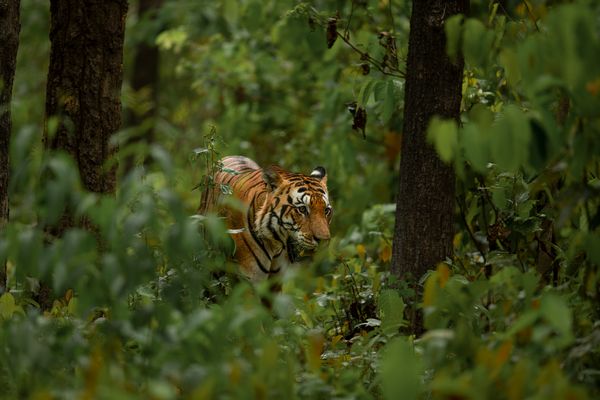Tourism in Kanha National Park
Ever since the passing of the judgement by Supreme Court in 2011 to restrict tourism to only 20% of the total area, the forest department has regulated tourism in a planned manner. Closing down some areas, and opening the buffer zones has not only restricted the human imprint on the core areas, but it has increased patrolling in the buffer areas as well now.
At the onset let us put things in clear perspective, only if there is wildlife will there be wildlife tourism. Hence conservation of wildlife is more important than tourism itself. It has been our endeavor since inception of our operation in year 2000 that Tourism becomes a tool for conservation. By creating an economy for the local community thus reducing the ever mounting pressures on the forest for bio-mass tourism has started to show results in many parks where the tourists numbers have increased, and this includes Kanha
Let us be clear upfront that Tigers do not recognize core or buffer differently. They will move in the areas which has prey, water, and ambush for the Tiger. People who know Kanha will know that the buffer in Kanha unlike many buffers in many national parks of India is far less disturbed comparatively. Infact if you are not told that you are entering a buffer zone you will not even get to know of the same, the habitat is so good even in buffers of Kanha.
The supreme court order also said to stop the Tiger shows from the Elephant back. A very welcome decision, as far Tigers are concerned. Most of the Jeep wallahs after entering the forest would head direct to the areas where Tiger show was going on. This considerably reduced tracking Tigers on the road by Jeep wallahs, and the Tigers were hardly seen from the Jeeps by the tourists. Ever since the Supreme Court stopped the Tiger shows, the drivers had no option but to work hard, and track Tigers for their guests. Initially there was limited success, but now it has turned into a great advantage for all wildlife and specially Tiger lovers. The Tiger sightings are happening regularly, and mostly at the end of the safari the summary is that different vehicles saw different Tigers.

Our Range Of Service

Tourism Zones
There are four tourism zones in which one can do safaris in Kanha, namely, Mukki zone, Kisli zone, Sarhi zone, and Kanha zone. While the first three are regular zones, the later, i.e. Kanha zone is termed as premium zone by the Forest department. Entry ticket to the premium zone is higher by 50% over other zones. There is a specific reason why Kanha zone was termed as the premium zone. Till about 4 years back the Tiger sightings in the Kanha zone, specially in the meadows was very good. But ever since the Tiger shows stopped, and the drivers were compelled to track Tigers the Tiger sightings improved in other zones as well. Then there has been a case of movement of a dominant male Tiger away from Kanha. The legendary Tiger Munna a 13 year old male Tiger has shifted his territory outside Kanha zone partially, and no new male has yet taken over the vacated territory thus reducing the Tiger sightings. Tiger sightings are very dynamic and can change quite swiftly for no known reasons initially, and it is only after a while you understand the reason why the sightings reduced in a particular zone. Please see my other note on Tigers of Kanha.

Entry Gates
There are three gates from where you can enter the forest. One is the Mukki gate, and it is best suited if you have booked the safaris in the Mukki zone. Second is the Khatia gate, it is best suited if you have booked your safaris in Kisli and Kanha zone. From this gate you can also enter the Sarhi zone. The third gate is Sarhi gate, from here you can enter Sarhi zone, Kisli and Kanha zone as well. There are good number of resorts of different budgets located near Mukki and Khatia gate. Sarhi gate still does not have good resorts yet.

Safari Vehicles
Jungle Safaris are conduced in two different types of vehicles, one the Jeeps, in which maximum 6 guests are permitted to sit alongwith a forest guide, and he driver. But we recommend maximum 4 guests to a Jeep due to comfort factor. The second type is an open safari bus which seats 12 guests plus a guide and a driver. This vehicle also known as a canter was launched only 2 years back, and there is only one vehicle per gate. To get an idea of the type of vehicle please click the link below. Both these type of vehicles are open from top, and there is no protection from sun, rain, or dust. You need to have proper head gear to protect yourself from sun if you so desire. Unexpected rains do come by once in a while, and usually there is no protection for the same.

Entry Permits
Very limited number of permits are available online to be booked 120 days prior to travel date. Anyone around the world can book the permits if the dates are certain. You need to input a recognized Photo Identity, i.e. a passport, a pancard, a driving license, an aadhar card, or a voter card. For Foreigners a passport is recommended. Important point to remember here is that you must carry the same photo id in original to be shown at the park entry gate when demanded. In absence of the original identity card the forest department can stop you from entering the park. A deposit is also to be paid to book the safari. The entry permit is non amendable, non adjustable once booked. If you wish to change names on the entry permit it is not legal. Hence be absolutely sure about the dates, and zones in which you wish to do the safari. It is always best to book the safaris, and the entry permits with the agent / hotel where you will be staying.

Forest Guide / Jeep Driver
As of now, every resort/lodge has two Jeeps permitted to go inside the park. For extra Jeeps there is a pool of Jeeps belonging to the local community which operates in a systematic roster. Most likely you do not get the same Jeep twice during the stay unless the hotel has booked you a hotel Jeep for you. Similarly the forest guides are mandatory to accompany you in the Jeep, and they also have a roster system. Most likely the guides are also not repeated more than once in your safaris. The Guides are the representatives of the Forest department in the vehicle, and they ensure the rules and regulations of the national park are followed by the tourists. They are mostly local, not very fluent in a foreign language, but very conversant with the wildlife of the area.
Having locals as guides is a very good idea, as it provides employment to the local community. Some resorts do have resident naturalists who accompany the guests on safaris. These naturalists have good communication skills, and they are also very knowledgeable of the local flora and fauna. You are best advised not to talk, or in whispers when you must. By talking amongst yourself, or with the guides too much, you are taking away the attention of the guides and drivers from listening to the alarm calls, or at times miss out on vital pug marks which can assist in tracking the Tigers.

Camera Fees
As on writing of this note in January 2020 there is no fees for still and video cameras.

Photography
When you come all the way to Kanha by investing your valuable resources, i.e. your money, time, and physical energy, then you must make most of the opportunity and make memories of your visit.
There are some do’s and dont’s before getting into photography in a national park.
- First and foremost is your’s and the animals safety. It is important to maintain a safe distance from the animal you are photographing.
- Never use flash in the Jungle during a safari. It can either turn away the animal, or a predator can get upset and even charge at the vehicle.
- When taking images of predators like Tigers, and Leopards, please make sure that you are not coming in their way of walking, or stalking any other prey animal.
- Never get close to cubs of predators or any other animal for that matter. In case of a predator a Tigress can charge at you if she notices your vehicle getting close to the cubs. The guides and driver of the vehicle are experienced and listen to their advise, do not push them to get a close up of a predator.
- Never get off the Jeep to take an image.
- Do not talk too much, if at all you must then please do in whispers as the predators usually leave the area when they hear you speak loud.
- If at all your photography equipment falls off the vehicle, then never ever jump out of the vehicle in presence of a predator. They can see this as a threat and charge at you unexpectedly. Let the guide and driver decide when and how to pick up the fallen equipment, however expensive.
- The safety of your equipment is your responsibility and not of the driver or the guide. It is best to carry small plastic bags to safely cover your equipment in case of unexpected rains and dust.
- It is important to have knowledge of the animal you plan to shoot, and also information on the national park you are visiting. It helps to know the behavior of a Tiger, for example if he is smelling a tree trunk, then he will either spray mark on the tree or do flehmen. You must be prepared accordingly. Such behavioral patterns make good images.

Tiger sightings
There are some pre-requisites before you enter the park for a safari. It is imperative that you have lot of patience, and perseverance when you go for safaris. Tiger sighting is a matter of luck, and you can maximize your luck by doing more and more safaris while visiting the national park. Enjoy the national park in it’s entirety, photograph all animals, every speck and atom in a park is unique, and deserves lot of attention, and there is a lot to learn. If the focus is only Tigers then they are best seen in the zoo.

Closest Town
If you are staying near Mukki gate, then the closest town is Baihar, about 15kms from Mukki gate. It has a small local market for purchase of some utilities. Bank and ATM’s are also here. Malanjkhand is another small town close by which has Asia’s largest Copper and Manganese mines.
If you are staying near Khatia gate, then there are some shops near the gate itself, or in Bahmni which is 30kms from Khatia gate.

Medical Facility
Baihar, Malankhand and Bahmni has doctors which can take care of some basic problems. Balaghat about 65kms from Mukki gate, and Mandla about 60kms from Khatia gate are the respective district headquarters. Both the districts have hospitals. But good medical facilities are only available in Raipur- 200kms, Nagpur- 275kms, and Jabalpur-200kms.

Weather
Kanha being a sal forest, the weather here comes as a surprise to many. Winters are extreme with minimum temperatures touching almost 0-2 degrees Celsius, while the day temperatures in winters are 20 degrees and above. Summers peak at about 45 degree celsius during the day, while the nights are about 20-24 degree Celsius.
The morning safaris in the winters are very chilly, and one should be prepared accordingly.

Children During Safaris
Though there is no age limit for young children to accompany parents during the safaris, but we recommend that kids under 3 years should not be taken for a safari. For no fault of theirs the energy and excitement levels of children can be a bit disturbing to other tourists in other vehicles specially when the predators are closeby. It can also disturb the predators.

Children During Safaris
Are best advised against the safaris due to uneven terrain / tracks. At times it can get unexpectedly bumpy, and despite best efforts from the drivers there are situations that can arise during safaris which are not conducive for pregnant ladies. Hence we recommend pregnant ladies not to do safaris.

Clothing / Attire
It is advisable to avoid wearing bright colours in the forest, as the same can distract the animals away from you. It is best to wear the colors like light browns, olive greens, and pastel shades which merge well with the forest.. We also suggest not wearing strong deo’s or perfumes as that also keeps the animals away. Also to keep in mind is that morning safari is 5 hours, and evening safaris is about 3 hours, so you should wear clothes which are comfortable in sitting for so long.
We must be sensitive to the fact that the senses of the animals are very sharp, and heightened to almost five times compared to a human. For example, the Tiger will hear your normal talking pitch amplified five times higher, and that is very disturbing to them as they are not used to the same in the silent environs of the forest.
Reaching Kanha National Park
Jabalpur : 200kms, 4 hours by car Raipur : 210kms, 4 hours by car Nagpur : 275kms, 5-6 hours by car
Gondia : 135kms, 3 hours by car Jabalpur : 200kms, 4 hours by car
ENQUIRE NOW
Lets plan your safari tour. Please fill the enquiry form below and our team will get back to you within 24 hours with a perfect safari package.






